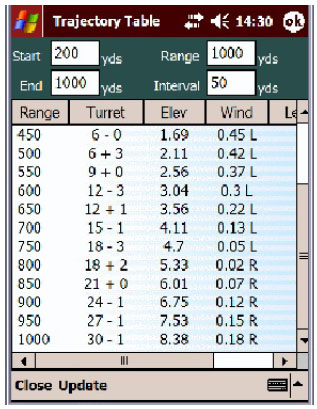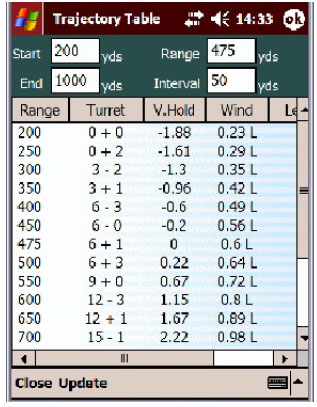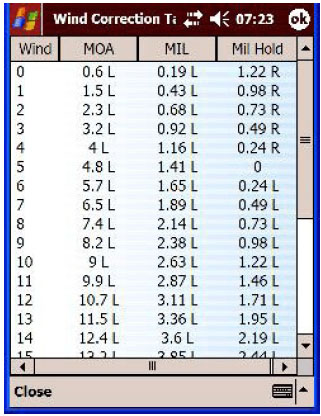I've been using Blaine Fields' PDA program, Field Firing Solutions, for several months. If you're not familiar with the program, check out the manual for the program, which is here:
http://www.precisionworkbench.com/Download/Manuals/FFS%20Manual.pdf
My wife and I were up in Colorado for much of the summer, and returned to find that Blaine had made some interesting additions to the program.
The first is on the main screen, which looks like this:

The new feature is the "PS" button, which pops up a new screen with all of the data which goes into the shot calculation: Pressure, Temperature, Humidity, Bullet Profile (caliber, weight, B.C., DK, Muzzle velocity, and Turret Profile.)
He also made some changes to the Trajectory Table screen, which displays firing data after the calculation. The screen looks like this:

The first change is that the program calculates bullet velocity at each range displayed in the table. It's in the last column to the right on that page - but you can also display it without scrolling to the right, by clicking on the Turret column. When you do that, the Turret column changes to Velocity. Click it again, and it toggles back to the Turret display.
Having the velocity is very handy, if you're concerned about whether your bullets are staying supersonic to a particular range. With this display, you can see where they go subsonic, if that's the case.
The second change is the addition of a Hold column, which you get by clicking on the Elevation column heading. When you do so, it changes from Elevation to Hold, and looks like this:

Note that the Hold column becomes 0 (zero) at the range specified in the Range window.
If you are shooting a drill like Moving Chaos at Rifles Only, where you must engage multiple targets at multiple ranges with tight time limits, this facility is <span style="font-weight: bold">very</span> handy. You can set the Range window for one range, and instantly see the holdovers and holdunders for your load for other ranges.
This program has become essential to me. Among the features I consider essential are the ability to include temperature sensitivity of the powder into the firing solution, and the Deceleration Coefficient, which allows you to tweak the elevation calculation to the actual measured field performance of your specific load.
Also, the Turret profiles will help keep you on the right turn of your multi-turn elevation turret, as well as show the correct setting for turrets which are not calibrated precisely in MOA. An example is my Leupold 6.5-20X50M1, whose clicks are labeled in MOA, but actually are in 1.0 inches per hundred yards (instead of 1.047 inches per hundred yards, which is true MOA.)
If you're in the market for a good ballistics program with advanced features, I think that there's nothing on the market even close to this one.
http://www.precisionworkbench.com/Download/Manuals/FFS%20Manual.pdf
My wife and I were up in Colorado for much of the summer, and returned to find that Blaine had made some interesting additions to the program.
The first is on the main screen, which looks like this:

The new feature is the "PS" button, which pops up a new screen with all of the data which goes into the shot calculation: Pressure, Temperature, Humidity, Bullet Profile (caliber, weight, B.C., DK, Muzzle velocity, and Turret Profile.)
He also made some changes to the Trajectory Table screen, which displays firing data after the calculation. The screen looks like this:

The first change is that the program calculates bullet velocity at each range displayed in the table. It's in the last column to the right on that page - but you can also display it without scrolling to the right, by clicking on the Turret column. When you do that, the Turret column changes to Velocity. Click it again, and it toggles back to the Turret display.
Having the velocity is very handy, if you're concerned about whether your bullets are staying supersonic to a particular range. With this display, you can see where they go subsonic, if that's the case.
The second change is the addition of a Hold column, which you get by clicking on the Elevation column heading. When you do so, it changes from Elevation to Hold, and looks like this:

Note that the Hold column becomes 0 (zero) at the range specified in the Range window.
If you are shooting a drill like Moving Chaos at Rifles Only, where you must engage multiple targets at multiple ranges with tight time limits, this facility is <span style="font-weight: bold">very</span> handy. You can set the Range window for one range, and instantly see the holdovers and holdunders for your load for other ranges.
This program has become essential to me. Among the features I consider essential are the ability to include temperature sensitivity of the powder into the firing solution, and the Deceleration Coefficient, which allows you to tweak the elevation calculation to the actual measured field performance of your specific load.
Also, the Turret profiles will help keep you on the right turn of your multi-turn elevation turret, as well as show the correct setting for turrets which are not calibrated precisely in MOA. An example is my Leupold 6.5-20X50M1, whose clicks are labeled in MOA, but actually are in 1.0 inches per hundred yards (instead of 1.047 inches per hundred yards, which is true MOA.)
If you're in the market for a good ballistics program with advanced features, I think that there's nothing on the market even close to this one.




